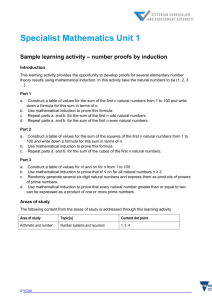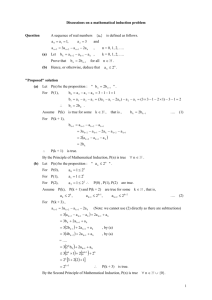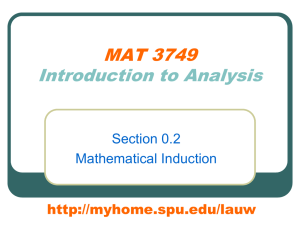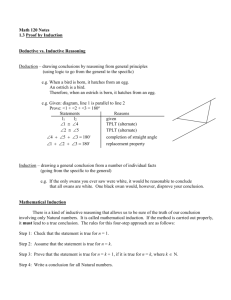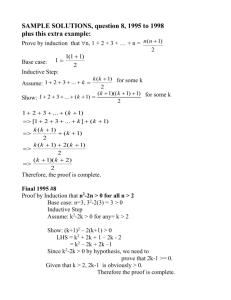Examples of mathematical induction proofs for the discussions
advertisement
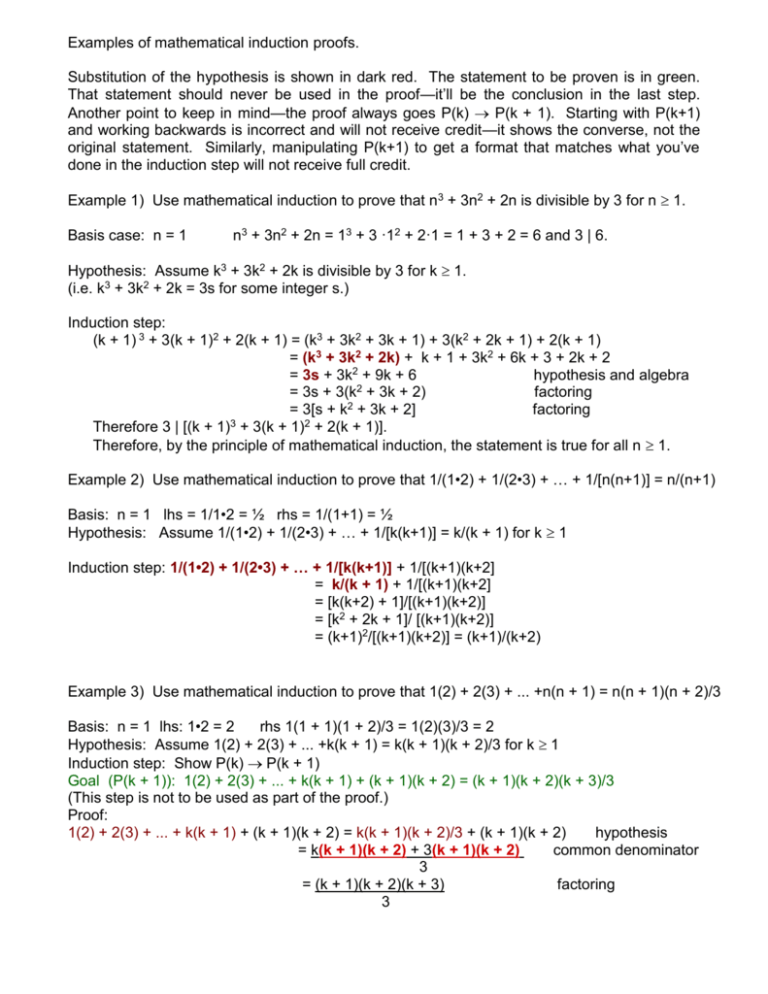
Examples of mathematical induction proofs.
Substitution of the hypothesis is shown in dark red. The statement to be proven is in green.
That statement should never be used in the proof—it’ll be the conclusion in the last step.
Another point to keep in mind—the proof always goes P(k) P(k + 1). Starting with P(k+1)
and working backwards is incorrect and will not receive credit—it shows the converse, not the
original statement. Similarly, manipulating P(k+1) to get a format that matches what you’ve
done in the induction step will not receive full credit.
Example 1) Use mathematical induction to prove that n3 + 3n2 + 2n is divisible by 3 for n 1.
Basis case: n = 1
n3 + 3n2 + 2n = 13 + 3 ·12 + 2·1 = 1 + 3 + 2 = 6 and 3 | 6.
Hypothesis: Assume k3 + 3k2 + 2k is divisible by 3 for k 1.
(i.e. k3 + 3k2 + 2k = 3s for some integer s.)
Induction step:
(k + 1) 3 + 3(k + 1)2 + 2(k + 1) = (k3 + 3k2 + 3k + 1) + 3(k2 + 2k + 1) + 2(k + 1)
= (k3 + 3k2 + 2k) + k + 1 + 3k2 + 6k + 3 + 2k + 2
= 3s + 3k2 + 9k + 6
hypothesis and algebra
2
= 3s + 3(k + 3k + 2)
factoring
= 3[s + k2 + 3k + 2]
factoring
Therefore 3 | [(k + 1)3 + 3(k + 1)2 + 2(k + 1)].
Therefore, by the principle of mathematical induction, the statement is true for all n 1.
Example 2) Use mathematical induction to prove that 1/(1•2) + 1/(2•3) + … + 1/[n(n+1)] = n/(n+1)
Basis: n = 1 lhs = 1/1•2 = ½ rhs = 1/(1+1) = ½
Hypothesis: Assume 1/(1•2) + 1/(2•3) + … + 1/[k(k+1)] = k/(k + 1) for k 1
Induction step: 1/(1•2) + 1/(2•3) + … + 1/[k(k+1)] + 1/[(k+1)(k+2]
= k/(k + 1) + 1/[(k+1)(k+2]
= [k(k+2) + 1]/[(k+1)(k+2)]
= [k2 + 2k + 1]/ [(k+1)(k+2)]
= (k+1)2/[(k+1)(k+2)] = (k+1)/(k+2)
Example 3) Use mathematical induction to prove that 1(2) + 2(3) + ... +n(n + 1) = n(n + 1)(n + 2)/3
Basis: n = 1 lhs: 1•2 = 2
rhs 1(1 + 1)(1 + 2)/3 = 1(2)(3)/3 = 2
Hypothesis: Assume 1(2) + 2(3) + ... +k(k + 1) = k(k + 1)(k + 2)/3 for k 1
Induction step: Show P(k) P(k + 1)
Goal (P(k + 1)): 1(2) + 2(3) + ... + k(k + 1) + (k + 1)(k + 2) = (k + 1)(k + 2)(k + 3)/3
(This step is not to be used as part of the proof.)
Proof:
1(2) + 2(3) + ... + k(k + 1) + (k + 1)(k + 2) = k(k + 1)(k + 2)/3 + (k + 1)(k + 2)
hypothesis
= k(k + 1)(k + 2) + 3(k + 1)(k + 2)
common denominator
3
= (k + 1)(k + 2)(k + 3)
factoring
3
Example 4) 12 - 22 + 32 - ... + (-1)n-1n2 = (-1)n-1n(n+1)/2 (Note: this implies n 1)
Basis: (n = 1)
lhs 12
rhs (-1)01(1 + 1)/2 = 2/2 = 1
Hypothesis: 12 - 22 + 32 - ... + (-1)k-1k2 = (-1)k-1k(k+1)/2
Induction step:
Goal (P(k + 1)): 12 - 22 + 32 - ... + (-1)k(k+1)2 = [(-1)k(k+1)(k+2)] / 2
(This step is not to be used as part of the proof.)
Proof:
12 - 22 + 32 - ... + (-1)k-1k2 + (-1)k(k+1)2 = (-1)k-1k(k+1)/2 + (-1)k(k+1)2
hypothesis
= [(-1)k-1k(k+1) + 2•(-1)k(k+1)2]/2
common denominator
= [ (-1)k-1(k+1)(k + 2•(-1)(k+1)) ] / 2
= [ (-1)k-1(k+1)(k -2k -2) ] / 2
= [(-1)k-1(k+1)(-k -2)] / 2
= [(-1)k-1(k+1)(-1)(k+2)] / 2
= [(-1)k(k+1)(k+2)] / 2
Example 5) Use mathematical induction to prove that (1 + ½)n 1 + n/2 for n 0
Basis: lhs (1 + ½ )0 = 1
rhs 1 + 0/2 = 1
Hypothesis: Assume (1 + ½ )k > 1 + k/2 for k > 0
Induction step: (1 + ½)k+1 = (1 + ½)k(1 + ½)
> (1 + k/2)(1 + ½)
= 1 + ½ + k/2 + k/4
= 1 + (k+1)/2 + k/4
> 1 + (k + 1)/2
(since removing a positive value makes right
side smaller)
Example 6) Use mathematical induction to prove that 2n < n! for n ≥ 4
Basis: n = 4 lhs 24 = 16 rhs 4! = 24 Since 16 < 24 the basis holds.
Hypothesis: Assume 2k < k! for k ≥ 4
Induction step:
Proof: 2k+1 = 2 • 2k
< 2 • k!
< (k + 1) • k!
= (k + 1)!
since k >=4
Therefore, by the principle of mathematical induction, the statement is true for all n ≥ 4.
Example 7) Use mathematical induction to prove that a set with n elements has n(n - 1)/2
subsets of size 2.
Basis: n = 2. If |S| = 2, it has four subsets, but only one of them, namely S itself has size 2.
2(2 - 1)/2 = 1 so the basis holds.
Hypothesis: Assume if S is a set and |S| = k, then S has k(k-1)/2 subsets of size 2.
Induction step: Let S be a set such that |S| = k + 1 and let x S. Let T = S - {x}. Clearly, |T| =
k. To count the number of subsets of size 2 from S, we need to consider two cases:
Case 1: x is not in the subset of size 2. In this case, all size 2 subsets are also size 2 subsets
of T which has k elements and there are k(k-1)/2 such subsets.
Case 2: x is in the subset of size 2. In this case, k subsets can be formed. Each contains x
together with one element of T.
Thus, the total number of subsets is k(k-1)/2 + k = [k2 - k + 2k]/2 = [k2 + k]/2 = k(k+1)/2
Another way to look at this: There are n ways in which a single element can be chosen. Then,
there are n-1 ways to choose the second element for the set. Since this counts each set twice,
we must divide by 2. This is a combinatorial proof.
Tracing the proof with a specific example. Let S = {a, b, c, d, e} and let T = S – {a} = {b, c, d, e}
The subsets of size 2 that contain elements of S can be broken down into two categories
size 2 subsets of T
{b, c}
{b, d}
{b, e}
{c, d}
{c, e}
{d, e}
Since T has 4 elements there should be
4(3)/2 = 6 such sets
size 1 subsets of T to which a has been added:
{a, b}
{a, c}
{a, d}
{a, e}
Since T has 4 elements, there are 4 such sets.
Thus, the total number of size 2 subsets of S is 6 + 4 = 10 = 5(4)/2, exactly the number the
theorem says we should have.
